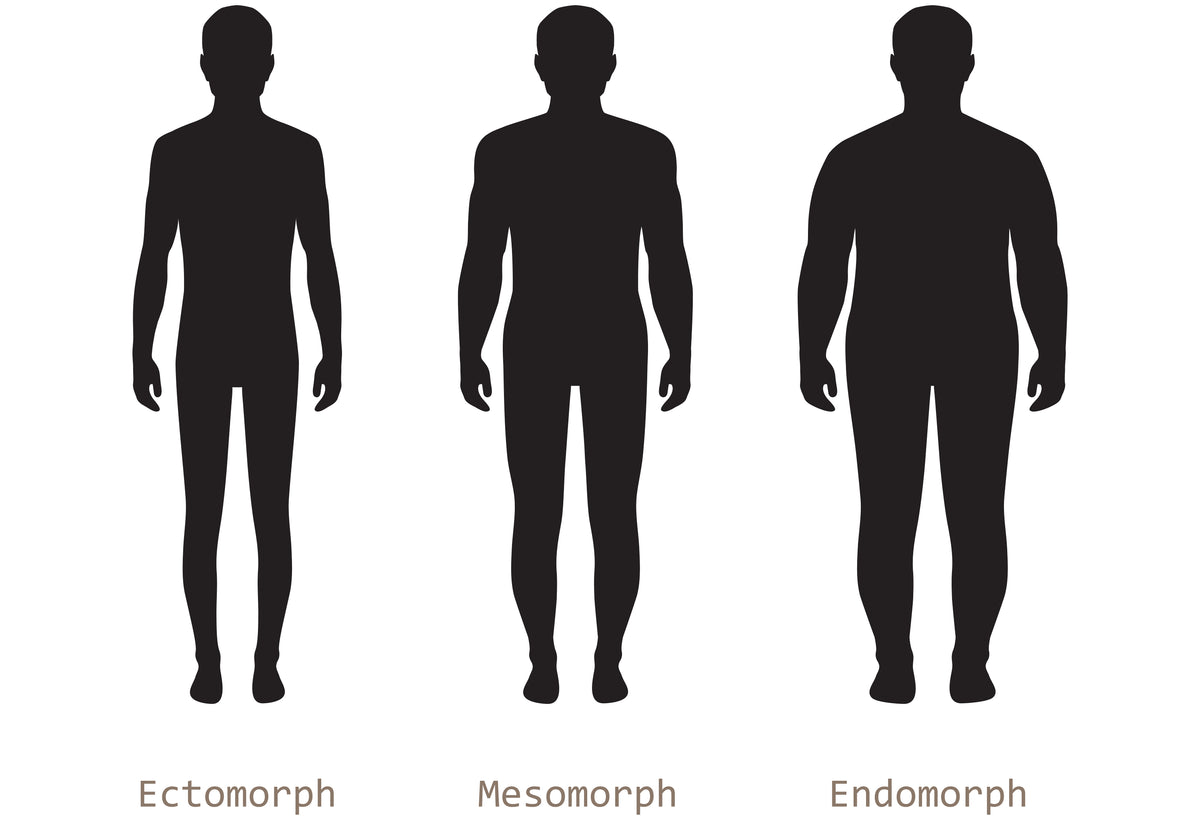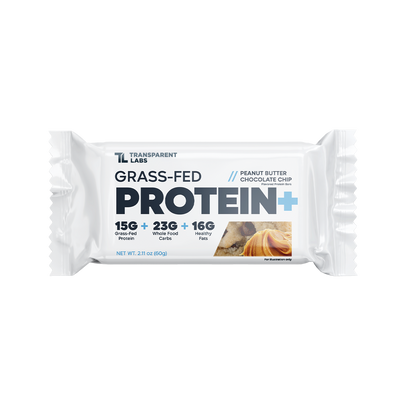What Are the Three Body Types? Diet & Exercise for Your Somatotype

How to Eat and Exercise for Your Body Type
If we all follow the same fitness routines, then we’ll see the same results, right? Well, not necessarily. Depending on your body type, you may need to eat and train a bit differently than others. Of course, there are no hard rules for building muscle and losing weight; trial and error is prudent to figure out what works best for you.
However, we can draw general guidelines for nutrition and training based on people's body types, aka "somatotypes." You may be familiar with the three somatotypes: ectomorph, mesomorph, and endomorph. (If not, we'll get you up to speed).
This article will walk you through the different body types and how they influence individual responses to diet and exercise.
What Are the 3 Body Types?
As humans, we naturally come in all shapes and sizes due to genetic variance. While we can undoubtedly change our physiques through exercise and diet, there are innate body features that we can't alter. For example, your bone structure is largely controlled by genetics. If you naturally have wide hip bones, you're not going to be able to change that through lifestyle interventions.
Over time, it's become apparent that the human body tends to fit into one of three main somatotypes with characteristic structural features: endomorph, ectomorph, and mesomorph. What differentiates these three body types is their morphology (e.g., long legs and short torso) and where they tend to hold onto fat tissue. A person's body type can also give hints about their metabolic tendencies (e.g., they respond better to a higher-carb diet instead of a ketogenic diet).
But the good news is everybody, regardless of body type (somatotype), can build muscle and lose weight. As you will learn in this guide, being an endomorph doesn't mean you're destined to be fat, just as being an ectomorph isn't an excuse that you can't gain weight. You have the power to change your body with the right plan and consistency.
Read on to learn actionable diet and training tips that cater to your specific somatotype.
Why You Should Lift Weights Regardless of Body Type

Before we dive into strategies based on the three body types, let's briefly discuss why weight training should be a staple of everyone's exercise regimen. The unique muscular adaptations to resistance training are not replicable through cardio or other forms of aerobic exercise [1]. Muscles are a bit stubborn — they won't hypertrophy (grow) without good reason. They need progressive overload, which is precisely what weight lifting can provide.
And to be clear, we're not talking about shoulder pressing 2lb dumbbells for ultra-high-rep sets. We're talking about slapping some relatively heavy weight on a barbell and challenging yourself. Strength sets the foundation for long-term muscle gains, which, in turn, will make fat loss easier.
Likewise, your muscles will eventually atrophy (shrink) if you remove exercise/resistance training from the equation after a period of bulking up. Hence, intense resistance training is a key exercise modality for gaining muscle and maintaining it. No matter your somatotype, lifting should get the priority over cardio if your goal is to improve body composition and increase strength.
If you're not sure where to start, be sure to check out our Guide to the Push-Pull-Legs Routine.
The Endomorph Body Type
Do you have a rather large bone structure, wide hip bones, and feel like you gain fat around your belly by just looking at a donut? You may have an endomorph body type. There's good and bad news for endomorphs: they can gain muscle and strength fairly quickly, but they also put on fat easily.
That being said, endomorphs can certainly develop a lean, muscular physique with the right approach. They need to be extra cautious during a bulking phase and staying consistent in the gym. Here are three strategies to follow if you're an endomorph that wants to build muscle and cut body fat:
Eat Mostly Nutrient-Dense Foods
For people who tend to overeat and/or put on body fat easily, the best thing to do is emphasize foods rich in nutrients (especially micronutrients and fiber) but not excessively high in calories. Essentially this means eating mostly whole foods that are more satiating than “empty-calorie” foods like butter, vegetable oils/dressings, full-fat dairy, candy, dark chocolate, etc.
Examples of nutrient-dense foods:
- Sweet potatoes/yams
- Oats
- Beans
- Nuts
- Lean animal protein (e.g., chicken breast and whole eggs)
- Cruciferous vegetables and leafy greens
- Fresh fruit
Don't forget to include a generous amount of protein with every meal to help promote muscle growth and recovery. Endomorphs generally respond better to a lower-carb diet with moderate amounts of protein and fat. You may need to cut back on carbs aggressively to get ultra-lean as an endomorph.
Do a Few “High-Intensity Interval Training” Sessions Every Week
Endomorphs stand to benefit by doing a few cardio sessions every week, even when trying to gain muscle. Cardio, especially high-intensity interval training (HIIT), helps stimulate mitochondrial biogenesis and increase post-exercise oxygen consumption [2]; in turn, your metabolic expenditure increases at rest, and you will stay leaner throughout the bulking process.
Implement 1-3 HIIT sessions weekly, based on how quickly you gain weight. A HIIT session can be as quick as 15-20 minutes if done properly and hard enough. For example, try starting with the following hill-sprint workout:
- Find a hill that is about 50-60 yards long
- Sprint as hard as you can to the top of the hill (should take about 10-15 seconds)
- Walk/jog slowly back down to the bottom of the hill for “active recovery” and to catch your breath (30-45 seconds)
- Repeat steps 2 and 3 for ten total intervals

When your goal is to lose weight, add a couple of low-intensity cardio sessions throughout the week to burn off a few extra calories. However, don't get carried away by doing hours of low-intensity cardio every day, as this can eat away your hard-earned muscle and make you "skinny fat." As long as your diet is under control, you shouldn't need much more than three or four 30-minute LISS cardio sessions per week (especially if you're already doing 2-3 HIIT sessions).
Don't Bulk Up "Too Much"
As an endomorph, you'll be able to pack on mass and strength quite rapidly with diligent resistance training, such as a powerbuilding routine. Unfortunately, many endomorphs get a little careless during their bulking phase and put on excessive amounts of body fat. Once it comes time to cut down and lose weight, they are discouraged by how far they have to see the muscle they gained.
If you're planning on bulking up, be mindful of your increase in body fat. It feels great to be big and strong, but controlling fat gain is crucial for long-term health and fitness.
The Ectomorph Body Type (aka “Hardgainer”)
People with an ectomorph body type generally have a lanky, slender build with a long torso, slim hips, and narrow shoulders. While endomorphs and mesomorphs tend to put on body fat easier than ectomorphs, the latter faces an ongoing battle to build muscle mass (or gain weight of any kind, for that matter).
If you find yourself being mocked as a “String Bean” every time you set foot in the gym, don’t worry; there are many strategies that can help overcome your genetic tendency to be slender (which is more of a gift than it is a curse). Here are key strategies for those with an ectomorph body type to pack on muscle mass and gain weight easily:
Calorie-dense foods are your ally
To make the process of eating large amounts of calories every day a little less strenuous, ectomorphs should emphasize calorie-dense foods. Examples of calorie-dense foods include:
- Avocados
- Whole milk
- 93/7 ground beef
- Salmon
- Coconut
- Nut butter
- Granola
For example, two tablespoons of peanut butter provide over 200 calories and will hardly fill you up. There is no excuse for not being able to eat enough, even if you're an ectomorph. You need to eat the right types of foods to reach your calorie goals every day.
Struggling to eat enough? Drink calorie-dense liquids
Intuitively, drinking calorie-dense fluids is much easier than consuming tons of whole foods. But that doesn't mean you should be slamming fruit juice around the clock just because you’re a hardgainer. Sugar-loaded beverages won't do much for helping you gain muscle mass.
Instead, focus on nutrient-dense liquids that are high in protein and calories. Transparent Labs MASS is a great mass gainer for ectomorphs since it's packed with quality protein, healthy fats, and a mix of fast-and-slow-digesting carbohydrates.

Keep cardio as low as possible, especially when building muscle mass is the primary goal
Cardio, specifically at low/medium intensities, is a means of increasing the number of calories you burn, which is directly antagonistic to most hardgainer’s goals. However, ectomorphs can still do some cardio and build muscle. Keep the cardio duration reasonable (i.e., 25-30 minutes) and relatively infrequent (maybe 2-3 times a week); intense resistance training and getting stronger should be your main concerns as an ectomorph that wants to build mass.
The Mesomorph Body Type
If you read the above sections for ectomorphs and endomorphs, you will find that the following suggestions fall right in between them. Being a mesomorph is actually quite a blessing for both building muscle and cutting body fat. This body type naturally has broad shoulders, fairly narrow hip bones, full muscle bellies, and shorter limbs.
However, that doesn’t mean mesomorphs will grow boundlessly if they slack on their training and don't eat properly. Much like the endomorph, a person with a mesomorph body type can put on excess body fat in a hurry if they're not careful.
Use the “90/10” rule for food choices
For mesomorphs, their diet should mostly be nutrient-dense foods like whole grains, lean proteins, unsaturated fat sources, fruits, and vegetables. However, they stand to benefit by incorporating some “junk" (empty-calorie) foods in their diet if they are craving something like a cookie or a burger.
Don't misconstrue that as saying you should go out of your way to eat less-wholesome foods just for the sake of it. The 90/10 rule means 90% of your foods from nutrient-dense sources and the remaining 10% can come from more traditional “junk” food.
During a bulking phase, some mesomorphs may fare better by enjoying a “free” meal once or twice a week where they eat whatever they’re craving (in moderation, of course) and don’t track the macronutrient intake.
Limit Cardio (but Don't Avoid it)
As a mesomorph, limiting cardio is wise, but it can actually be beneficial to keep a few HIIT and low-to-moderate intensity sessions in the mix every week. Remember, cardio is basically a supplement to resistance training.
Perform 1-2 HIIT sessions and a few 30-minute low-to-moderate-intensity cardio sessions weekly. Preferably, do HIIT on days that you do not lift weights, and do the remaining cardio on days that you lift.
(See the “endomorph” section above for an example of what a typical HIIT session may look like.)
Find What Works Best For You
Naturally, you will have to employ trial and error along with the tips provided above to determine what's optimal for your body. Having an open mind to try new tactics when things aren't going as planned will only help. Don’t be afraid to switch things up and get out of your routine.
And if it ain't broke, don't fix it. Progress is progress. Be patient and stay the course until you stall. There are no shortcuts to creating the body of your dreams. (Well, there are some, but you get the idea...)
For more in-depth guides based on body types, read:









